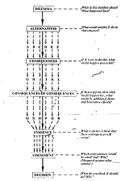01 - Value Analysis: A Method for Analysing Cases in Research Ethics and Research Integrity
01 - Value Analysis: A Method for Analysing Cases in Research Ethics and Research Integrity
Members of The Embassy of Good Science have developed a set of six user-friendly, accessible methods for analysing research ethics and research integrity cases.
These methods have been identified, adapted and presented so that they can be appropriated by all users, without prior philosophical knowledge, in local contexts.The key aim for the case analysis method described here is that it can be appropriated by all users, without prior philosophical knowledge, in local contexts.
In order to apply this method in the analysis of specific cases, it is advised that RECs, RIOs and IRBs engage with the regulatory frameworks and normative standards that apply to their respective organizations in the form of codes of ethics, codes of conduct, funding body standards and, if applicable, broader national and international research ethics and research integrity regulatory documents.What is this about?
This case analysis uses a procedure advanced by Jack R. Fraenkel (1976) for the purpose of values education.[1] Fraenkel (1932-2013) earned a PhD from Stanford University in 1966 and subsequently worked at San Francisco State University for more than 30 years. When he retired, he was Professor of Interdisciplinary Studies in Education.[2]
- ↑ Fraenkel, Jack, R. (1976). Teaching about Values. In: Ubbelohde, Carl, and Jack R. Fraenkel. (Eds.) Values of the American Heritage: Challenges, Case Studies, and Teaching Strategies. The Bicentennial Yearbook, 46th Yearbook." (1976).
- ↑ Obituary (2014). Jack Fraenkel Obituary, San Francisco Chronicle on Mar. 7, 2014, https://www.legacy.com/obituaries/sfgate/obituary.aspx?n=jack-fraenkel&pid=170037290 (accessed on March, 15th 2019)
Why is this important?
Fraenkel published a lot on research methodology, curriculum development and research in education. Guided by the work of Coombs and Meux[1], Fraenkel (1976) advanced an interesting method to analyse value conflicts meant for teachers “[…] to help students determine for themselves what individuals caught in value dilemmas should do […]”.[2]
- ↑ Coombs, Jerrold R., and Milton Meux, ‘Teaching strategies for values analysis’. In: Metcalf, L. E. (Eds.) (1071). Values education: Values education: Rationale, strategies and procedures. Washington D. C.: National Council for Social Studies. S. 29–74.
- ↑ Fraenkel, Jack, R. (1976). Teaching about Values. In: Ubbelohde, Carl, and Jack R. Fraenkel. (Eds.) Values of the American Heritage: Challenges, Case Studies, and Teaching Strategies. The Bicentennial Yearbook, 46th Yearbook." (1976).
Practical Tips
A case analysed by this method is openly available on the Zenodo repository and can be accessed using the following link: https://doi.org/10.5281/zenodo.4905905
What is the incident about?
What is the dilemma?
What might (the central character) do to try and resolve the dilemma?
What alternatives exist?
What might happen if he or she does each of these things?
What might be the consequences of the various alternatives?
What might happen to those who are not immediately involved?
What might be the short- as well as the long-range consequences?
What evidence, if any, is there that these consequences would indeed occur?
What could be considered as forseeable consequences?
Would each consequence be good or bad? Why?
Is there a positive balance between good and bad consequences?
What do you think X should do?
What do you think is the best thing for X to do?
Remarks
Ad. 1: Fraenkel stresses the importance of identifying whether the conflict is about ends or means to ends that have been agreed upon. Equally important is to establish the factual context of the situation.[1]
Ad. 2: This step involves brainstorming for all the available action alternatives for the agent(s) facing the value conflict at hand.
Ad. 3 and 4: These questions are focused on the expected consequences of the different alternative actions available to those facing the value conflict. What might be the effects of each alternative respectively? Which parties might be affected? Could the consequences spill over to future generations? It might make sense here to distinguish between short- and long-range effects for the individual and other parties. In order to map these consequences, a Values Information Chart (Table 1) could be used.
| Facts | Alternatives | Consequences | |||
| Short-Range | Long-Range | ||||
| Self | Others | Self | Others | ||
Ad. 5: This question zooms in on the evidence supporting or refuting the potential effects of the alternative actions as identified above. If the case at hand is similar to case studies from the past, it might be useful to study what happened there. Data to that effect should be gathered, and their truthfulness and relevance to the case at hand established.
Ad. 6: A discussion of the desirability of the expected consequences is needed. This should happen based on certain criteria. These criteria might be of a moral, legal, aesthetic, ecological, economic, health and safety and/or a completely different nature. A Value Analysis Chart (Table 2) could be used to keep track of the assessment of the different consequences along the different criteria. In the last column of this chart the desirability of the different consequences is ranked from the most to the least desirable.
Ad. 7: Fraenkel does not explain how the answer to this final question should follow from the analysis above. It seems to be implicit in his method that the answer automatically matches the alternative that turns out to be most desirable over all.
| Alternatives | Consequences | Desirability from various points of view | Ranking | ||||||
| Moral | Legal | Aesthetic | Ecological | Economic | Health and Safety | Etc. | |||
- ↑ Fraenkel, Jack, R. (1976). Teaching about Values. In: Ubbelohde, Carl, and Jack R. Fraenkel. (Eds.) Values of the American Heritage: Challenges, Case Studies, and Teaching Strategies. The Bicentennial Yearbook, 46th Yearbook." (1976).


